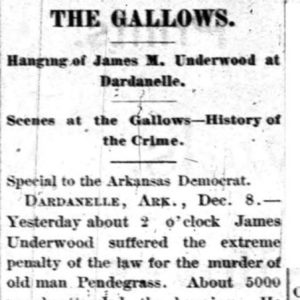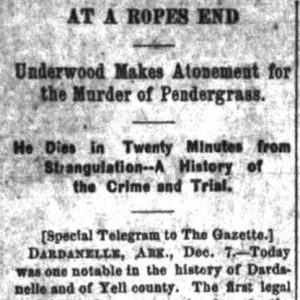calsfoundation@cals.org
James M. Underwood (Execution of)
James M. Underwood was hanged on December 7, 1883, near Dardanelle (Yell County) for the shotgun slaying of a prominent local farmer.
James M. Underwood, a native of Tennessee, lived at the home of “well-to-do farmer” Robert J. Pendergrass about five miles south of Dardanelle, as he worked on the Pendergrass farm. However, “an intimacy between Mr. P.’s wife and Underwood caused a quarrel in the family, which ended by Underwood changing his home.” He moved in with Joshua Toomer nearby.
On September 1, 1883, Pendergrass drove his wagon into Dardanelle to conduct some business. When he was nearing his home later that day, “he was fired on from the brush and killed instantly.…Mr. P. had received the buckshot in the back of his head and shoulders.” His frightened mule team fled until the wagon was stuck against a tree, and Pendergrass slumped over, his head touching the wagon wheel.
Investigators found a place in the brush where branches had been cut away and discovered “some bits of powder and burnt domestic [cloth]” that Toomer recognized as coming from his shot bag. Going to his home, they found his shotgun “out of its accustomed place and unloaded,” and Underwood lying in bed.
He was arrested and soon confessed to the murder, saying, “Yes, I done it and I just feel so bad about it that I had as soon be dead as alive anyhow, and so I just thought I would take an honest course and die right.”
In a written confession published in the Russellville Democrat, Underwood said that he had continued seeing Pendergrass’s wife, that they met “in the yard and other places at night for criminal purposes some seven or eight times,” and that she urged him to kill her husband. He eventually took Toomer’s shotgun and killed the farmer from ambush.
Underwood was tried and convicted of first-degree murder in September 1883. His original October execution date was delayed so that he could testify against Emma Pendergrass, who denied involvement in the crime and received a change of venue to Conway County, where she was acquitted of her husband’s murder. Underwood escaped from jail in October but was soon caught, and his hanging was scheduled for December 7, 1883.
The gallows were erected on a hillside in a field a mile west of Dardanelle, and a crowd of 5,000 people gathered to watch Underwood die. The murderer fainted at the foot of the scaffold and, after being revived, “did not feel like talking.”
“At 2:05 the trap was sprung and the body was swinging in the air,” the Arkansas Gazette reported. “His neck was not broken, and death was brought about by strangulation.” He was declared dead twenty minutes later. The Arkansas Democrat claimed that the lawmen who oversaw the hanging “conducted the whole affair as quietly and with as much decency as such public executions are ever conducted.”
Underwood’s was the first legal execution conducted in Yell County. In contrast, three men had been lynched in the county in 1881, as were two others earlier in 1883.
For additional information:
“Arkansas State News.” Arkansas Weekly Mansion, November 17, 1883, p. 2.
“Assassinated.” Arkansas Democrat, September 4, 1883, p. 4.
“Assassination.” Russellville Democrat, September 6, 1883, p. 2.
“At Rope’s End.” Arkansas Gazette, December 8, 1883, p. 1.
“Dardanelle.” Arkansas Gazette, November 3, 1883, p. 1.
“The Gallows.” Arkansas Democrat, December 8, 1883, p. 2.
Mark K. Christ
Central Arkansas Library System
 Law
Law Post-Reconstruction through the Gilded Age, 1875 through 1900
Post-Reconstruction through the Gilded Age, 1875 through 1900 James Underwood Execution Story
James Underwood Execution Story  James Underwood Execution Story
James Underwood Execution Story 




Comments
No comments on this entry yet.